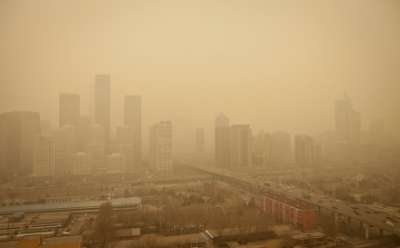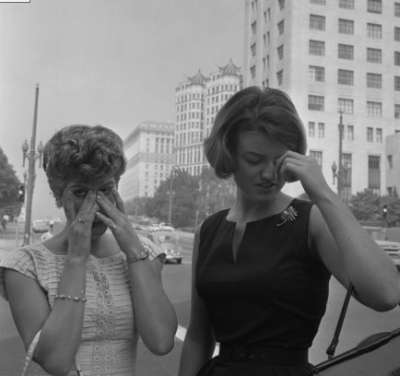A tale of two cities

Yifang Zhu, an associate professor in the UCLA Fielding School of Public Health, and her colleagues are drawing on lessons from Los Angeles and teaming with Peking University scientists to guide policy makers as Beijing grapples with record levels of air pollution.
Nowhere is the situation more urgent than in Beijing, where in January the U.S. Embassy measured fine particulate matter in the air and found it to be 35 times the World Health Organization's recommended standard.
Outdoor air pollution played a role in an astounding 1.2 million premature deaths in China in 2010, according to the 2010 Global Burden of Disease Study, published in the British journal The Lancet. Even more ominous is the likelihood that the problem has escalated in the three years since. Earlier this year, the Chinese government reported that particulate pollution was 30 percent higher than for the same period in 2012.
Air pollution, especially particulate matter measuring 2.5 microns or smaller in diameter (PM2.5), has become a high-priority topic among policy makers in China. In March the government announced it would spend 100 billion yuan (the equivalent of $16 billion) over the next three years to tackle Beijing's pollution woes.
Zhu, who is also associate director of the Center for Clean Air and a member of the UCLA Institute of the Environment and Sustainability, is part of a group of researchers at UCLA and Beijing's Peking University who are collaborating on a series of studies on particulate matter pollution, including figuring out how motor vehicle emissions are affecting air quality in Beijing.
And while Peking University, one of China's leading academic institutions, boasts an active research program focusing on air pollution in Beijing, the partnership with Zhu and colleagues—forged through the Joint Research Institute in Science and Engineering, which promotes collaborative work between UCLA and Peking University faculties—has particular value.
"Beijing can draw lessons from the experience of Los Angeles," said Zhu, who has studied air pollution in both cities. "Thirty years ago, Los Angeles was just as bad as today's Beijing."
Zhu's goal is to provide guidance to policy makers as they grapple with an issue of growing concern. "The Chinese government has begun to invest significant resources in air quality research, hoping to use the science to develop regulations and other policies that will lead to improvements," she explained.

In Los Angeles, Zhu noted, rapid economic development in the 1970s contributed to dangerously high levels of particulate matter. But aggressive regulatory measures — including changes in fuel and vehicle emission standards — led to dramatic improvements in air quality, even as the traffic volume increased substantially.
In Beijing, the major source of concern is with the levels of PM2.5, which come mostly from combustion sources and are considered to be a greater public health threat than larger particles because they penetrate the human respiratory system more deeply.
"These are suspended particles in the air that people breathe, with a variety of respiratory, cardiovascular and other effects that have been documented in the research literature," Zhu noted. "When their concentration is high, they also dramatically reduce visibility, which is when most of the public perceives the problem."
The U.S. Environmental Protection Agency first adopted a national ambient air quality standard for PM2.5 levels in 1997. PM2.5 is not currently regulated in Beijing, but the Chinese government is moving toward establishing a national standard.
Los Angeles and Beijing are different in many ways, Zhu noted. Los Angeles' unique topography and climate — surrounded by mountains and regularly bathed in sunshine, making the basin susceptible to ozone and oxidized particulate matter formation — combine with its car-dominant culture to present significant air quality challenges. "In Los Angeles, we are dealing with emissions from our own basin that get cooked by the sun," Zhu said. "But in Beijing, they are subject to their own sources as well as industrial emissions from surrounding cities."
While motor vehicle traffic is also a major concern in Beijing, other lifestyle factors are important, including how residents cook and use their energy. Zhu and her UCLA and Peking University colleagues are in the early phases of their research, but already they have made a surprising observation — that a significant portion of particulate matter in Beijing, even near roadways, comes from cooking activities. "The high-temperature wok style of cooking all over the city generates a large number of particles in the air," she explained. "Our finding illustrates the importance of understanding the characteristics of local pollutants so that you know where to focus resources, and then developing policies that reduce emissions in a cohesive way."
Despite these differences, Zhu said, there are plenty of lessons Beijing can draw from the experience of Los Angeles, particularly when it comes to the issue of motor vehicle emissions. Zhu explained that there are three approaches to tackling the problem:
- Improving the quality of the fuel, so that each gallon burned emits less;
- Improving the technology of the vehicles, so that each gallon of fuel stretches more miles;
- Reducing the number of vehicle miles driven in the basin through strategies such as public transportation, carpooling and other incentives to reduce driving.
In Los Angeles, Zhu noted, the first two approaches have played a much larger role in improving air quality than the third; in fact, her group measured particulate matter emissions around a busy section of Interstate 405 near UCLA in 2001 and again in 2011, and found a dramatic reduction despite increased traffic volume over the 10-year period.
"This is not to say that we shouldn't work on reducing vehicle miles traveled," Zhu said. "But changes in fuel and vehicle technology can be implemented much more easily at a societal level. In Beijing, more stringent vehicle emission standards and cleaner fuel could produce many benefits."
Beijing's Environmental Protection Bureau lacks the regulatory infrastructure of the South Coast Air Quality Management District and U.S. Environmental Protection Agency, which can enforce policies under the Clean Air Act. But Chinese government actions in advance of the 2008 Summer Olympics in Beijing, which dramatically lowered emissions — albeit temporarily — show that change is possible, Zhu said.
Cultural differences, including the much greater preponderance of smokers in Beijing than in Los Angeles, also present a challenge. "It can be harder to sell the importance of clean air to someone who smokes a pack of cigarettes a day," Zhu said.
Nonetheless, she believes public sentiment on behalf of change has grown as the air has gotten dirtier: "People are not happy about what's going on," Zhu said. "These are not easy problems, but the experience of Los Angeles shows that they are solvable."
Journal information: The Lancet
Provided by University of California, Los Angeles


















